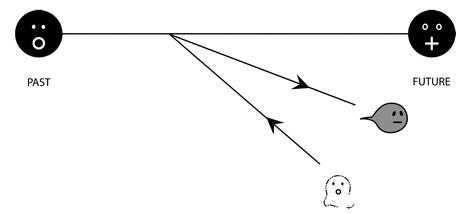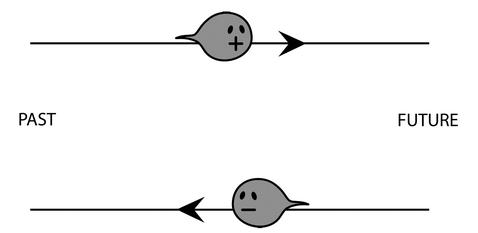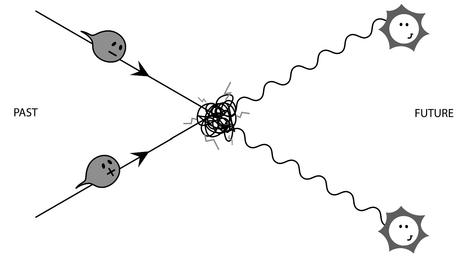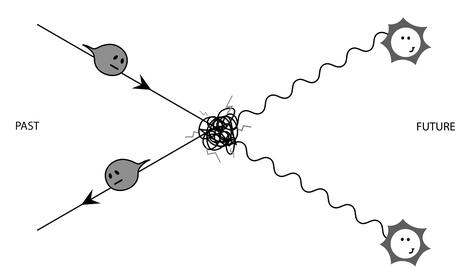NINETEEN
Ettore’s Neutrino
What did Ettore pull out from his drawer to win the concorso? Nothing less than the “little change he’d set aside in the hope of becoming Rothschild” (as he’d written), the appendix to his 1932 article that he’d left to rot for five years. At long last, he bothered to bestow this wisdom upon the world, as part of his last attempt to join reality and be normal—when he patently wasn’t. We are now ready for Ettore’s neutrino; I make no apologies for the detour.
Ettore’s 1932 work—his infinite tower of particle states—was perceived by many as a dead end, not least by Ettore himself. But even admitting that its story is hardly finished, it’s undeniable that it led to a major insight into the neutrino—as a mere, trifling offshoot. Fermi placed Ettore in the same category as Newton and Galileo—I’d have added Einstein. Such people have a knack for being right even when they’re wrong. Einstein missed the prediction of the cosmological expansion—the Big Bang—by fudging his gravity theory with the infamous “cosmological constant,” or energy of the vacuum. Eighty years onward, we’re sure that the universe is expanding—in that respect Einstein was wrong—but also that there might be something similar if not identical to vacuum energy presiding over this expansion. Even when he was wrong, Einstein turned out to be right in some sense. The same may be true of Ettore and his disagreement with Dirac.
Ettore never got over his 1933 disappointment regarding Dirac’s negative-energy sea and the antiworld. The paper he submitted for the concorso, “Symmetrical Theory of the Electron and Positron” opens with the barefaced line, “The interpretation of the so-called ‘states of negative energy’ proposed by Dirac . . . is not completely satisfactory.” He acknowledged the positron; however, he bypassed the sea of negative energies whenever he could: The neutrino being a case in point. He hoped that his “purely formal” construction might help future generations to address all particles without Dirac’s sea of negative energy. For someone so self-destructive and pessimistic, it’s remarkable that Ettore had such a distaste for negative energies.

In order to understand Ettore’s response to Dirac’s theory, it may be useful to appeal to a visualization of the antiworld due to Richard Feynman and Ernst Stueckelberg. Alice uses a mirror to access an alternative version of our world, and her tripping method leads to the notion of chirality. What Feynman and Stueckelberg realized is that antiparticles and negative energies could be understood by appealing to yet another tripping technique.
Consider a world that’s like ours but where time goes backward. That is, imagine that the time-flow in your consciousness remains unchanged, but that everything else is ruled by a reversed arrow of time. This is the premise in Martin Amis’s amusing but ultimately sobering novel Time’s Arrow. Amis’s novel begins with its main character waking up from the “blackest sleep” to find himself in hospital surrounded by doctors. A few days later, the man is taken home in an ambulance, abandoned in the garden by paramedics, and an incredible world is revealed: a universe of “diametrical mistakes.” Language makes no sense. Songs sound utterly stupid and films have the most absurd plots. Lightning rods emit huge sparks toward the clouds during storms. A comprehensively disgusting description of a visit to the bathroom is included, complete with a depiction of the act of flushing the toilet backwards in time.
In Amis’s reverse world, love affairs begin with rows, leading to happy times and then a gradual estrangement. Train tickets bear the name of the starting point, not the destination, and are dispensed by garbage bins. Creation is easy (whole cities spring into being during earthquakes); destruction is laborious and protracted. A reverse of moral values is in place: Kind people take money from the church bowl, for example. Hospitals are places where the most atrocious crimes are perpetrated, the victims brought already in poor health, but then cruelly damaged further by doctors and nurses, to finally be dumped in a dreadful state in the middle of a street. The fact that the main character is a doctor leads to a breakdown between himself and his conscience (doubling as narrator), which can’t cope with the slaughter in the emergency room. Until one day something dramatic happens; and the world around this man starts to make sense.

Figure 19.1a: A depiction of a negative energy train going from London to Paris. The train leaves at noon and arrives at four pm (the time difference between France and Britain is irrelevant for the argument).
Feynman realized that Amis’s reverse world is the haunt of antiparticles and negative energies. Dirac’s negative energies can be seen as positive energies going backward in time, and vice versa. Suppose that a negative-energy train goes from London to Paris, leaving at noon and arriving at four pm (see Figure. 19.1a). All we know is that at four pm, at a train station in Paris, negative energy in the form of a train appeared. But from the point of view of someone on the platform, negative energy appearing is equivalent to positive energy disappearing. Thus the picture is equivalent to “a positive-energy train left Paris at four pm.” Likewise, at noon, a negative energy train left London, and this can be seen as a positive-energy train appearing. Our negative-energy train trip can therefore be understood as a positive-energy train leaving Paris at four pm and arriving in London at noon; i.e., going backward in time (see Figure 19.1b).

Figure 19.1b: The situation is equivalent to a positive energy train going backwards in time. Such a train leaves Paris at four pm and arrives in London at twelve noon. To understand this, note that the departure of a negative-energy train is the same as the arrival of a positive-energy train (in both cases, the energy in the station increased.)
If instead of a train we consider an electrically charged particle traveling backward in time, we interpret it “forward in time” as a particle with opposite charge. If a cosmic-ray positron hits a detector, the detector gains energy and positive charge. This is equivalent to the detector losing negative energy and negative charge; i.e., emitting a negative-energy electron. Except that this particle is now traveling backward in time, toward the supernova where it was born, the womb that serves as its deathbed, according to the backward arrow of time. Supernovae no longer pollute the galaxy with high-energy particles: Instead, they Hoover up negative-energy particles.
Figure 19.2: In Feynman’s picture a positive-energy positron (top) is equivalent to a negative-energy electron going backward in time (bottom).
Dirac’s negative-energy particles transplanted to Amis’s world yield the antiworld. And so Feynman proclaims positrons to be negative-energy electrons going backward in time (see Figure 19.2). An electron is now a particle that has its meals like any civilized human being, eating her soup and meat, and finishing with a dessert and a glass of spirit. A positron is a twin particle that begins her dinner by throwing up her food, then processes and repackages the vomit, taking the outcome to a shop to be “promptly and generously reimbursed” for all her efforts.
According to Feynman and Stueckelberg, when a positron and an electron annihilate, in effect we have only one particle. An electron went to the place where a large amount of energy was emitted in the form of light—exactly twice the amount of energy corresponding to the mass of the electron, as computed with E = mc2. What happened at the annihilation point? The electron not only shed the energy in its mass but stole an equal amount of negative energy. Thus, twice the energy present in an electron was emitted. The electron then took the negative energy and started going backward in time—we see it as a positron. The annihilation process is like an electron pulling a U-turn down the stream of time (see Figure 19.3a and 19.3b).
Figure 19.3a: When an electron and a positron annihilate, in the far future we have two photons but the original two particles have disappeared.
Figure 19.3b: But the same process can be seen as an electron reversing down the stream of time. The electron and positron present in the remote past are then interpreted as a single particle, which underwent a change in the orientation of its time’s arrow.
Alice’s and Amis’s methods of tripping interact even beyond the worse combinations you may hear from street junkies. You might think that the two should never be taken together, but in fact, particles going backward in time are necessarily pushed into Alice’s mirror wonderland. Recall that right-and left-handed particles are so defined depending on how they spin with respect to their direction of motion. But the velocity of a particle doesn’t change in Amis’s world, because velocity is the distance traveled divided by the time elapsed. Both become negative in the backward world (distance from A to B counts as minus the distance from B to A), so the particle’s velocity hasn’t changed. In contrast, its direction of spinning has changed.
Thus, by going backward in time, we also jump through the mirror. A left-handed particle becomes a right-handed antiparticle and a right-handed particle a left-handed antiparticle. If you do Amis, you have to do Alice. This darkly mirrors the antimoral that assists the world going backward. It’s not only left- and right-handed people that swap in Amis’s world. The kind old man, when reversed, steals toys from children and takes them to the store for cash. Pimps, however, generously provide for their charges, also curing them with magic flicks of the wrists, miraculously erasing the bruises and cuts the doctors inflicted on them.

What happens if the antiworld meets the neutrino? First, let me give you Dirac’s version of the story. During beta decay, a neutron decays into a proton, an electron, and a neutrino. Protons and neutrons were known to belong to a class of particles capable of experiencing strong nuclear forces, called hadrons. Electrons and neutrinos stood aside—they didn’t feel the strong force—and belonged to a separate class called leptons. If one believes that the total number of leptons must remain the same, then the neutrino emitted in beta decay must be an antineutrino, so that it counts as minus-one lepton particle. There were no leptons before the beta decay, so if in the end an electron was emitted, then a minus-one lepton must also be present: the antineutrino (see Figure 19.4). Such was Dirac’s perspective, and the only way to enforce the prejudice that the total number of leptons must be conserved.

Figure 19.4: In beta decay à la Dirac, for lepton number to be conserved, the neutrino emitted must in fact be an antineutrino; i.e., a neutrino going backward in time. The electron and neutrino’s arrows then flow continuously from one to the other, just as in a creation or annihilation process. In fact, the process can be seen as the creation of a lepton antilepton pair, in many ways similar to the creation of an electron and positron.
Dirac’s view of the neutrino, however, had a major flaw. The neutrino is maximally chiral: It can only be left-handed, with no mirror image present in nature. Due to the way Amis and Alice interact, the antineutrino must then necessarily be right-handed, with no left-handed antineutrinos present in nature. Both neutrino and antineutrino are Draculas: If they look at themselves in the mirror, they see nothing. They’re Dracula and anti-Dracula, because no right-handed neutrinos or left-handed antineutrinos exist.
But why are there no right-handed neutrinos, and why no left-handed antineutrinos? Dirac’s theory has “slots” for these types of particle, but they are never filled. It makes space for them, but they don’t take it up. Why?
The mystery was solved by Ettore. His proposal for how the neutrino reacts to the antiworld differed completely from Dirac’s. If a particle is charged, it clearly must be different from its antiparticle, because if we make it go backward in time, its charge reverses. But if a particle is electrically neutral, or charge-free—like the neutrino—the story is different. We may then insist that a particle going backward in time is different from its forward version, just as Dirac did. But it isn’t necessary.
Figure 19.5: The Majorana neutrino doesn’t know past from future, because it flows down the two conflicting arrows of time. Therefore the Majorana neutrino is its own antiparticle.
Ettore proposed that a neutrino is indistinguishable from an antineutrino, that particle and antiparticle are the same. He boldly asserted that a neutrino going backward in time is the same as a neutrino going forward in time. That what you call a neutrino is in effect a quantum superposition of particles going both forward and backward in time, in equal measure, or with equal probabilities, so that there’s no asymmetry. And you thought Schrödinger’s cat was schizophrenic, unsure about life and death. Ettore’s neutrino is worse: a psychotic superposition of conflicting arrows of time made possible by the quantum ability to superpose opposites.
There is no arrow of time for a Majorana neutrino, because it contains within itself both time directions (see Figure 19.5). Majorana music might be defined as all songs that sound the same if played forward or backward. Odd music, one might think, but equally pleasing or displeasing in our world or in Amis’s. Ettore’s neutrino treats the two arrows of time democratically: It’s ambidextrous in time. It simultaneously throws up and eats its meals. A Majorana neutrino flushing the toilet defies imagination.
The only change for a Majorana neutrino going backward in time is its handedness. A left-handed Majorana neutrino becomes right-handed. The mystery of the unoccupied states in Dirac’s perception of the neutrino is at once solved. There are no empty slots in Ettore’s theory. What you see is all there is: one slot for a right-handed neutrino, another for a left-handed neutrino. Make time go backward, and they just interchange.
The neutrino is still maximally chiral, but only because of the way it interacts with other particles. In beta decay, only right-handed neutrinos are emitted, whereas in inverse beta decay only left-handed neutrinos can be used as bullets. So there’s handedness, but only in the way neutrinos talk to the world. Majorana’s neutrino isn’t a Dracula. If the left-handed neutrino gazed at a mirror, it would see a right-handed reflection. Particle and antiparticle are the same, but the neutrino does have a mirror image.
This designer clock illustrates well the interaction between time reversal and parity. It’s twenty-four past three.
Lepton number is not conserved in Majorana’s theory, because the lepton number of the neutrino is zero. But this has never bothered anyone, because lepton-number conservation is a prejudice rather than a law. Majorana neutrinos can annihilate themselves. They also have several other oddities. But it’s not easy to distinguish them experimentally from Dirac neutrinos. In fact, the constructions proposed by Majorana and Dirac are both realized in nature for other neutral particles which we know to be nonfundamental. The neutral kaon is a Dirac particle, whereas the neutral pion is a Majorana particle. The current score is 1-1, but this was a friendly match. With regard to the neutrino, the question is wide open.
Ettore admitted that an experimental choice between his option and Dirac’s was not available, but this was twenty years before the neutrino was even detected. Later, “in the 50s and in the 60s the opinion was frequently expressed that neutrinos a la Majorana, although beautiful and interesting objects, are not realized in nature,” as Pontecorvo wrote in 1982. But Pontecorvo went on to stress that things had changed, declaring the “question raised by Majorana” to be the “central question in neutrino physics.” On March 26, 1938, Ettore disappeared, but not before leaving us this central problem. We’re fortunate enough to live at a time when the controversy is about to be settled.

It was in this wild frame of mind that Ettore went to Naples in 1938: Having won his exalted position “by exceptional merit” with a paper proposing the Majorana neutrino, a particle for which the arrow of time doesn’t exist—even though time flows, but in both directions at once. How befitting, given what was to come.
In Ettore’s neutrino world, people both age and become younger at the same time. They first see the light of day soon after leaving a grave and a womb. Rivers stream from mountains to sea and from sea to mountains; but there’s only one water, flowing without whirlpools or obstructions. The traffic goes both ways down the alley of time. Majorana neutrinos remember both their past and their future in a deluge of nostalgia and déjà-vu.
Suicide isn’t a possibility in Amis’s world: You have no choice but to eventually vanish into your mother. In Ettore’s world, suicide is and is not an option. We’re outside the duality of choice and imposition, ordering and disordering, positive and negative energy. When you look up at the sky, light leaves your eyes toward the stars but also springs from the cosmos. Tales begin with happy ever after, but also with a prince going hunting in the forest. Plot? You wanted a plot? Ettore’s neutrino is like losing the plot.
Vanishing and appearing are one. Ships simultaneously leave wakes and cover their tracks as they progress along the seas. Welcome to Ettore’s world, revealed just before he went to Naples—his last home on this side of reality. Assuming reality has sides.












